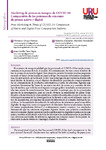Marketing de prensa en tiempos de COVID-19: Comparativa de los patrones de consumo de prensa nativa y digital

Use this link to cite
http://hdl.handle.net/2183/38770
Except where otherwise noted, this item's license is described as Atribución-NoComercial-CompartirIgual 4.0 Internacional
Collections
- Investigación (FEE) [923]
Metadata
Show full item recordTitle
Marketing de prensa en tiempos de COVID-19: Comparativa de los patrones de consumo de prensa nativa y digitalAlternative Title(s)
Press Marketing in Times of COVID-19: Comparison of Native and Digital Press Consumption PatternsDate
2021Citation
Crespo Pereira, V., Vaca Tapia, A. C., & Martínez Fernández, V. A. (2021). Marketing de prensa en tiempos de COVID-19: Comparativa de los patrones de consumo de prensa nativa y digital. Uru: Revista De Comunicación Y Cultura, (4), 194–209. https://doi.org/10.32719/26312514.2021.4.6
Abstract
[Resumen] El contexto de excepcionalidad que ha provocado el COVID-19 ha tenido consecuencias en la prensa de todo el mundo. El confinamiento ha visto crecer el hábito de leer la prensa en su versión digital. Esta situación permite formular muchas preguntas
en torno al futuro de las tiradas en papel y el tipo de consumo informativo pospandemia.
En este sentido, se ha llevado a cabo una investigación aproximativa, enmarcada en el ámbito de Ecuador, con el objetivo de identificar patrones de comportamiento de los consumidores de productos informativos a través de ediciones digitales que permitan determinar las bases de un nuevo modelo de acceso a y consumo de este tipo de medios, que todavía, en el espacio sociogeográfico estudiado, se encuentra en una fase inicial de transformación. Esta cuestión constituye uno de los principales aportes de la investigación, pues no puede obviarse la sensibilidad de países como Ecuador a la incidencia de crisis sanitarias o catástrofes naturales, en que el acceso a la información es esencial. La investigación se ha llevado a cabo en el momento más crítico de la pandemia, por suponer un punto de inflexión en el consumo habitual de periódicos. Se ha analizado la evolución de indicadores de relevancia para los modelos digitales de negocios, como el engagement de diecisiete diarios ecuatorianos durante los meses prepandemia (febrero) y confinamiento (marzo a mayo). Los resultados demuestran que las cabeceras migrantes digitales tienen una posición consolidada entre el consumo digital, mientras que los medios nativos digitales locales son los que mayor incidencia han tenido a la hora de informar a la ciudadanía sobre la pandemia. Las cabeceras nacionales de referencia registran un consumo mayor de los países vecinos ante la alerta vivida en Guayaquil, ciudad de Ecuador. [Abstract] The exceptional situation that has caused COVID-19 has had consequences in the press around the world. Confinement has replaced the habit of reading the paper press for the digital version. This situation allows many questions to be asked about the future of print runs and the type of post-pandemic information consumption. In this sense, an approximate investigation has been carried out, framed in the field of Ecuador, with the aim of identifying behavior patterns of consumers of informational products through digital editions that allow to determine the bases of a new access model and consumption of this type of media which, in the socio-geographical space studied, is still in an initial phase of transformation, a question that constitutes one of the main contributions of the research; Therefore, the sensitivity of countries such as Ecuador to the incidence of health crises or natural disasters cannot be ignored where access to information is essential. The investigation has been carried out at the most critical moment of the pandemic, as it represents a turning point in the inflection of the habitual consumption of newspapers. The evolution of relevant indicators for digital business models such as the engagement of 17 Ecuadorian newspapers during the pre-pandemic months (February) and confinement (March to May) has been analyzed. The results show that digital migrant newspapers have a consolidated position among digital consumption, while local native digital media are the ones that have had the greatest impact when informing citizens about the pandemic. The national capitals of reference register a higher consumption of neighboring countries due to the alert experienced in Guayaquil, city of Ecuador.
Keywords
Marketing
Prensa
Ecuador
COVID-19
Comportamiento del consumidor
Press
Consumer behavior
Prensa
Ecuador
COVID-19
Comportamiento del consumidor
Press
Consumer behavior
Editor version
Rights
Atribución-NoComercial-CompartirIgual 4.0 Internacional
ISSN
2631-2514






